How to source architectural salvage
Advice on finding and using vintage and reclaimed items
There are many reasons why architectural salvage recovered from remodelled or demolished properties is worth including in your renovation or self-build.
Often they come with an attractive aged patina that can be difficult – if not impossible – to replicate, and handmade older items may have beautifully crafted details that bring unique character to a project. Reusing second-hand items also reduces the amount of construction waste going to landfill, which is good for the environment.
Fixtures such as flooring, windows, doors and fire surrounds, and building materials such as brick and timber beams, can be sourced from salvage yards and dealers across the country. Follow this advice to help you track down the best finds.
Searching takes time
If you have an architect or designer working on your project, let them know at the briefing stage that you’d like to use reclaimed materials, and which ones, so they can help you find what’s needed. Contact salvage specialists with a list of your requirements, as they may also be willing to track down items in a suitable condition and quantity.
This is all likely to take longer than buying new, as will preparing reclaimed items for installation, so allow extra time in the schedule of works. You may also need somewhere to store what you buy as it becomes available.
Buyer beware
Before handing over any money, inspect the items carefully and avoid pieces that are damaged. Some wear and tear is inevitable, even desirable, but steer clear of significant faults – particularly with structural materials. Take your architect or builder with you for a second opinion. And make sure to ask the dealer where the items came from, as this may help you identify the genuinely reclaimed from new products that have been made to look old.
A Salvo Code certificate indicates that the dealer adheres to a voluntary code of good practice in responsible sourcing. Members may also use Truly Reclaimed labels, which provide reassurance that a product is old not new.
Does it comply with Building Regulations?
Architectural salvage is permissible under Building Regulations as long as it meets the relevant standards. For instance, doors and windows must satisfy safety, thermal and ventilation requirements, so obtain an assessment from an architect or member of a Competent Person Scheme before buying. Unless they have been adapted by an expert, electrical fittings, staircase components and balustrades are unlikely to measure up.
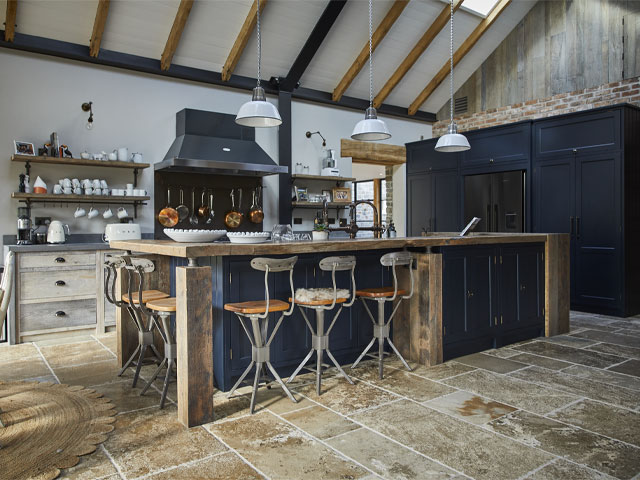
This bespoke kitchen by The Main Company features a kitchen island made from reclaimed oak, as well as reclaimed oak beams and shelving
Where to look for architectural salvage
Salvo should be your first port of call. Search for a dealer near you, or browse items for sale. Lassco, which has sites in London and Oxfordshire, is a great place to head for architectural salvage, antiques and curiosities. It regularly offers quirky pieces from the National Maritime Museum, Eton College, Harrods, Oxford University and Kew Gardens, as well as churches and institutions.
Visit the annual Salvo Fair, or shop directly at salvoweb.com. Arthur Swallow Fairs runs four decorative antiques and salvage shows at venues around the country over the summer. Suppliers and dealers such as Mongers Architectural Salvage, Dorset Reclamation and Original Baths sell fully restored items.
There are plenty of niche architectural salvage companies, specialising in the like of refurbished radiators, reclaimed tiles, second-hand doors, window frames and brickwork, as well as internal fittings, vintage furniture and accessories.
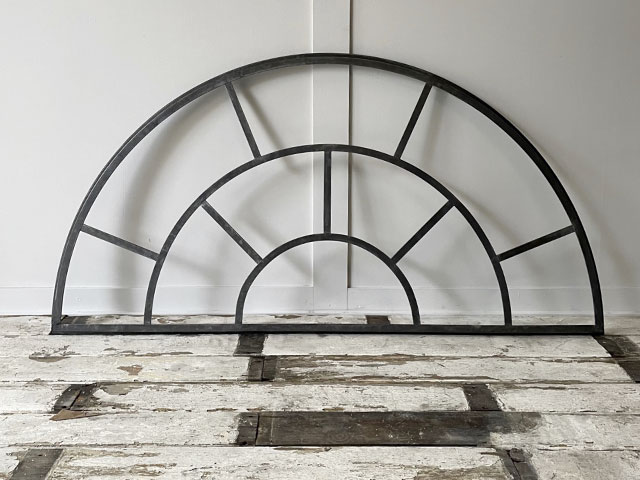
Refurbished arched Crittall window from The Old Yard
Refurbished radiators
Refurbished cast-iron radiators have a lot to recommend them. ‘They were built by craftsmen,’ says Fiona Triplow, founder of The Old Radiator Company. ‘The metal content and quality of casting are of a very high standard and it’s still possible to find unique, historical pieces.’
Be wary of unrestored designs that may have hidden cracks or corroded parts, often only apparent once the radiator is sandblasted clean to remove old paint or tested for performance. Refurbished models will have been flushed through to remove silt, pressure-tested for leaks and equipped with valves so they’re compatible with modern pipework.
Ribble Radiators will restore and paint any cast-iron gems you have found in your chosen colour.
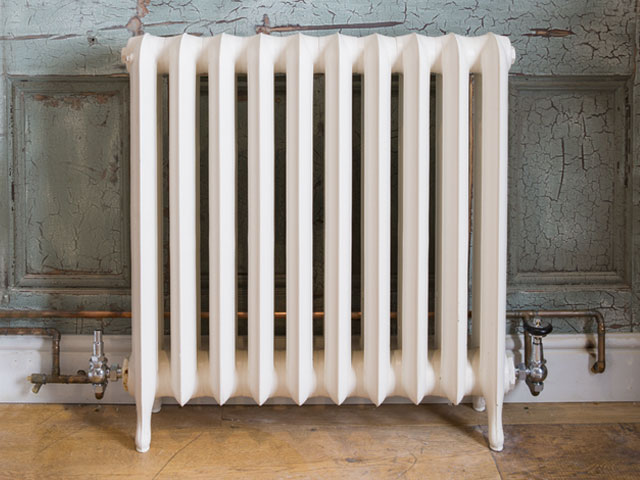
A cast-iron Princess radiator from The Old Radiator Company painted white
Windows, doors and bricks
Second hand doors, window frames and brickwork are perennially in demand. Reclaimed brick is ideal for a renovation or extension when it’s important to incorporate character and blend the new-build with the look of the original building.
But old bricks cost considerably more than new ones, and you will need to budget carefully before starting. For the extra outlay, you can find more interesting colours and textures, especially from pre-1900 handmade varieties. For your roof, you may want to invest in old tiles and slates, and vintage peg tiles are particularly sought after.
Attractive solid timber doors can be stripped and windows, especially the traditional box sash, are popular – and vital for the architectural integrity of some historic properties. Small, lightweight windows fitted into an internal door can turn a plain barrier into a feature piece.
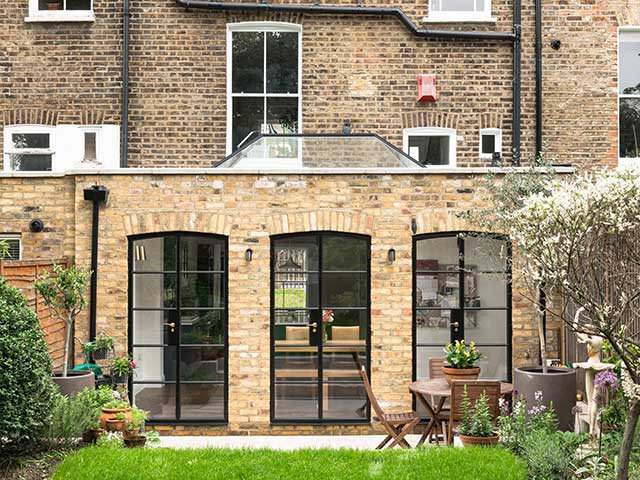
Reclaimed bricks from London Bricks link this extension to the original façade. Photo: William Eckersley for MW Architects
Antique tiles
The pattern of an encaustic tile is created by different coloured clays, rather than by the glaze. Most reclaimed encaustic tiles are original 18th, 19th and 20th-century designs that have been cleaned and restored by hand.
‘Antique tiles benefit from having been sealed several times over the years,’ says Chris Gulson-Brooke, founder of Maitland & Poate. ‘They are very hardwearing, and stains don’t easily penetrate the surface.’
As reclaimed tile patterns are no longer produced, the designs are often rare and unique. This makes it even more important to measure the space carefully than with new tiles. Don’t forget to buy more tiles than you need to allow for possible mistakes and breakages.
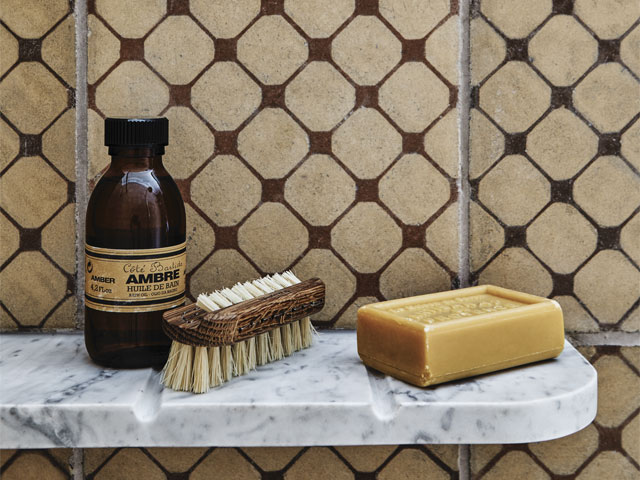
These antique encaustic tiles from Maitland & Poate were sourced from an old Haçienda near Granada, Spain. Bathroom by Mark Lewis Interior Design
Reclaimed flooring
Buying second-hand flooring is relatively straightforward. It’s possible to find old wood floors in black, strip or solid board formats. Aged timber comes with a patina that is difficult to replicate and is an environmentally sound choice.
You’ll need to decide whether you’d rather pay a premium for salvaged timber that’s been cleaned and restored or would prefer to source untouched wood from a reclamation yard. The latter will be cheaper but will require work to bring it up to scratch.
‘See a sample first and buy from a reputable dealer who can confirm provenance and adheres to the Salvo Code,’ says Nick Newman of Lassco.
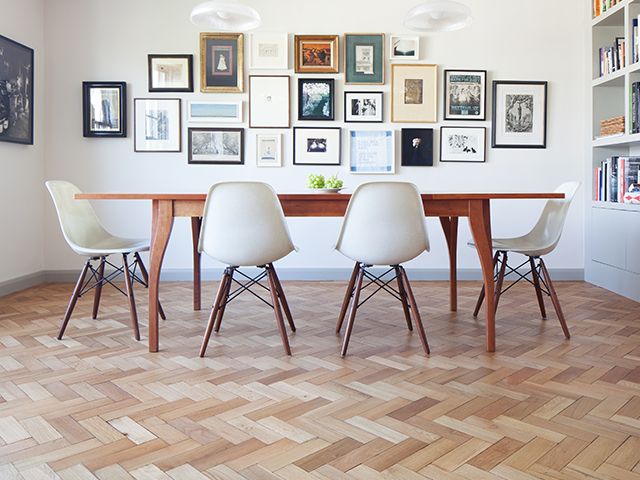
Reclaimed English Oak Herringbone by The New & Reclaimed Flooring Co
Light fittings
Industrial-style enamelled pendant lights that look as though they were salvaged from a factory are easy to come by – but the real deal is often far better made, and comes with that impossible-to-replicate patina of age, and a backstory.
All old lights will need rewiring by someone qualified to do so, but if you buy from a reclaimed lighting specialist such as Trainspotters or Skin Flint, this will usually have been done for you.
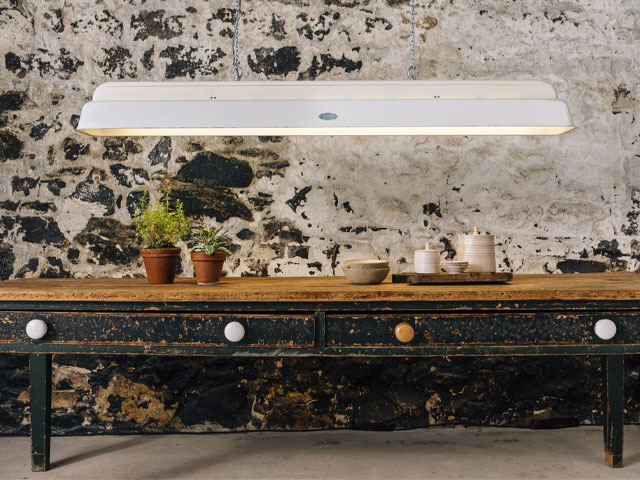
This reclaimed light by British manufacturer Benjamin was recovered from a decommissioned power station and rewired to comply with electrical regulations. Available from Skin Flint
Salvaged baths and sinks
Period sanitaryware can stand the test of time very well, and even with a vast array of antique-style baths, basins and taps available brand new, some types can be found only by going for a reclaimed model. Ask the seller whether taps have been restored and tested; and when plumbing them in you’ll need special adaptors to connect to modern pipe sizes. Water and Wood is a great source for restored bathroom taps and accessories.
Bear in mind that if you’re not buying a restored bath from a specialist, such as Antique Bathrooms, you may need to have the enamel redone.
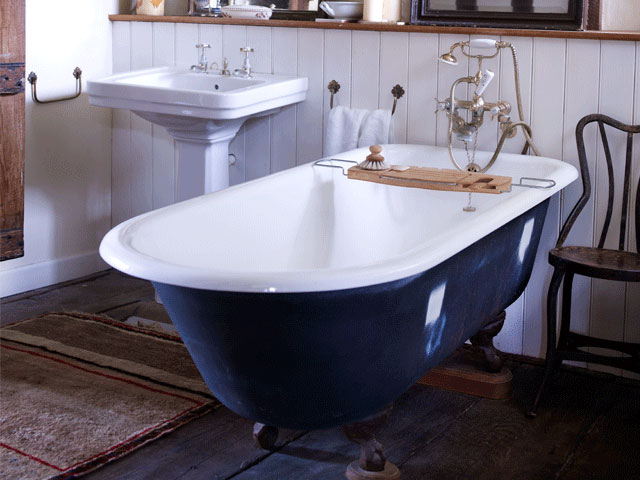
This salvaged sink and bathtub came from Retrouvius. Photo Debi Treloar
Internal fittings
Ideas for interiors include using old hardwood surfaces, such as from industrial workbenches, to make water-resistant bathtub surrounds. Try old barn cladding to make a rustic-looking oversized headboard, bakery racks as bookshelves, or agricultural feeding troughs as garden planters. Or use a length of marble slab for a kitchen upstand.
The architectural salvage dealer Retrouvius sells pine planks, once used for storing cheeses, that can become rustic wall cladding or cabinet door and drawer fronts, and they spend lots of time cleaning and restoring the stock. But you will pay a premium for the finesse, so if it’s a bargain you’re after, you may prefer a more rough-and-ready yard to scour.









